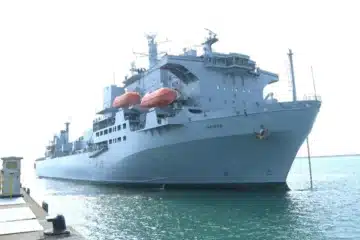In accordance with the “Global Britain” policy, the UK government has already signaled its desire for a more capable Royal Navy with the Integrated Review 2021, which was published in March 2021. Another indication of this policy was the deployment of the Queen Elizabeth carrier strike group in the Indo-Pacific region for seven months and the appointment of a navy admiral as Chief of Staff.
As a result, such a significant increase in the Royal Navy’s budget was to be expected development.
“Over the ten years from 21/22, we plan to spend £238 billion on equipment procurement and support, an increase of £48 billion from last year’s report. In April 2021, we assessed the equipment plan to have £4.3 billion of headroom over ten years, compared to a shortfall of £7.3 billion in the previous
report.”
The Defence Equipment Plan 2021 – 2031
Key issues about Royal Navy
The following are the most important remarks about the Royal Navy’s 10-year defense equipment plan:
- Planning to spend £38.1 billion in the equipment plan over the next ten years compared to £30.6 billion at the end of the previous planning period.
- Investing in a new lightweight torpedo for the Royal Navy ships and aircraft to replace current Stingray weapon.

- Procuring a highly capable ship to ship missile to replace current Harpoon missile system which will go out of service in 2023.
- Additional investment for the Merlin helicopters to be extended in service from 2029 until 2040.

- Having world-leading autonomous minehunting capability to replace legacy platforms.
- Increasing the capability and size of the Royal Navy’s surface fleet and allow the development of three Fleet Solid Support Ships, a Multi-Role Ocean Surveillance Capability, Multi-Role Support Ships and Type 31 and Type 32 frigates.

- Extending the life of three of the Royal Navy’s most recently refitted ships, with two of our oldest Type 23 Frigates being taken out of service.
- Launching the UK-designed cutting-edge Type 26 Anti-Submarine Warfare frigates alongside Canada and Australia

- Investing in missile and sensor upgrades for the Type 45 Sea Viper system, in directed energy weapons and in our test and evaluation capabilities.
The construction of the new National Flagship, announced by the UK Prime Minister on 30 May 2021, will be delivered by the Department of Defence but is not included in the document’s costings.
The document also mentioned the impact of the COVID-19 outbreak, which delayed the PIP (Propulsion Improvement Program) of Type 45 destroyers and caused obstacles to enterprise capacity to deliver the three maritime aviation programs simultaneously.







